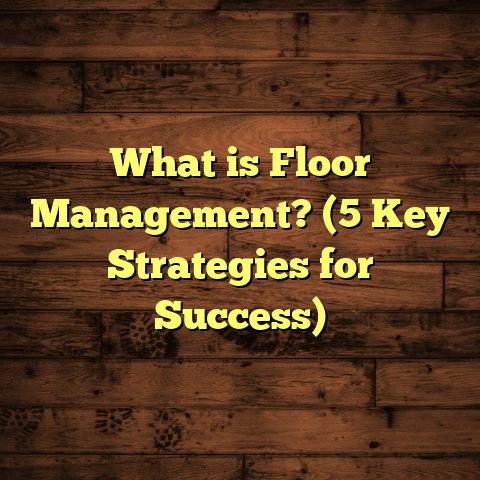What Is Worm Damage in Old Wood Floors? (5 Signs You Need to Know)
I still remember the first time I noticed worm damage in an old wood floor. It wasn’t just a few scratches or scuffs; it was something that felt deeper, almost like the floor was telling me a secret it had been hiding for years. Have you ever walked across an old wooden floor and felt a sudden creak or noticed tiny holes scattered around? Maybe you brushed away some fine dust, wondering where it came from. Well, that was worm damage—one of the most overlooked but critical issues in old wood flooring.
If you’ve ever wondered what worm damage exactly means, how to spot it, why it happens, and what to do about it, you’re in the right place. I’ve spent years working in flooring restoration and repair, and I’ve learned that worm damage isn’t just a cosmetic problem. It can threaten the very structure of your floors—and eventually your whole home’s safety.
Let me take you through everything I know about worm damage in old wood floors, sharing my personal experiences, data-backed insights, and practical advice. By the end of this conversation, you’ll know how to protect your floors and save yourself a lot of trouble and money.
What Is Worm Damage in Old Wood Floors?
Simply put, worm damage refers to the destruction caused by wood-boring insects—commonly called woodworms—that infest timber and eat their way through it. These “worms” aren’t worms at all but larvae of beetles that bore into wood to feed and grow.
The most common culprits are larvae from beetles like:
- The common furniture beetle (Anobium punctatum)
- The deathwatch beetle (Xestobium rufovillosum)
- The powderpost beetle (several species in the family Lyctidae)
What happens is this: Adult beetles lay eggs on or inside wooden structures. When larvae hatch, they start tunneling through the wood as they feed. These tunnels weaken the timber, causing structural damage over time. Eventually, adult beetles chew their way out, leaving behind tiny exit holes on the wood surface.
In old wood floors, this process can go unnoticed for years because the damage happens inside the wood. The surface may look fine initially, but underneath lies a network of tunnels that compromise strength.
Why should you care? Because while worm damage might start small, if left untreated it can cause floors to sag, creak, or even collapse. It also lowers property value and can spread to other wooden parts of your home.
Understanding the Lifecycle of Woodworms
Understanding how woodworms operate helps explain why worm damage often stays hidden until it’s severe.
Here’s a quick rundown of their lifecycle:
- Egg Stage: Adult beetles lay eggs in cracks or pores of untreated or damaged wood.
- Larval Stage: Eggs hatch into larvae (the actual “woodworms”), which burrow deep inside the wood, feeding on cellulose. This stage can last from months to several years depending on conditions.
- Pupal Stage: Larvae pupate inside the wood before emerging as adult beetles.
- Adult Stage: Adult beetles chew exit holes through the wood surface and fly off to mate and lay eggs.
The larval stage is when most damage occurs—because they’re tunneling and eating through the timber from within.
In my experience, this hidden feeding phase is why homeowners often don’t realize they have a problem until they see adult beetles flying around or notice surface damage.
Why Are Old Wood Floors Vulnerable?
You may ask: “Why do these beetles target old wooden floors specifically?”
Here are some reasons:
- Old Wood Tends to Have Cracks or Gaps: Over time, wood naturally develops cracks or gaps from drying and wear. These openings provide entry points for beetles to lay eggs.
- Moisture Content: Beetles prefer damp wood because it’s easier for larvae to chew and provides a better breeding environment. Old floors in damp basements or poorly ventilated areas are at higher risk.
- Lack of Modern Treatments: Many old floors were installed without modern chemical preservatives or sealing finishes that could deter beetles.
- Type of Wood: Some softwoods and hardwoods are more susceptible than others. For example, oak tends to resist better than pine.
- Neglected Maintenance: Floors that haven’t been sealed or maintained regularly become more vulnerable.
In one house I worked on, the floorboards were covered by layers of carpet for decades. Moisture trapped underneath created perfect conditions for deathwatch beetles to thrive unnoticed.
Five Signs That Show You Have Worm Damage
Spotting worm damage early can save you thousands of dollars and prevent serious headaches. Let me share five signs I always look for when inspecting old wood floors:
1. Tiny Round Exit Holes
Exit holes are small round holes—usually between 1mm and 3mm in diameter—where adult beetles have chewed their way out of the wood after maturing.
They’re often scattered across floorboards or skirting boards.
I once inspected an old cottage where these holes looked like pinpricks all over the floorboards. The owners thought they were just nail holes or imperfections but they were actually exit points of active infestation.
If you see these holes in clusters, don’t ignore them—they mean larvae have hatched inside and adult beetles have emerged.
2. Fine Powdery Dust (Frass) Near or Beneath Boards
Frass is a mixture of sawdust and insect droppings produced by larvae as they burrow through wood.
You’ll often find it as fine dust piles near skirting boards, under loose boards, or along cracks in flooring.
One time, during a renovation project, I found thick layers of frass trapped between floorboards—indicating the infestation was ongoing.
If you notice unexplained dust gathering near your floors, grab a flashlight and inspect closely.
3. Hollow or Weak Sound When Tapped
Tapping on solid wood normally produces a sharp knock sound. But worm-damaged wood often sounds hollow or dull because internal tunnels weaken the structure.
I carry a small hammer when inspecting floors. Tapping suspected boards helps me find hollow spots before visible damage shows up.
If your floor creaks more than usual or sounds different when walked on, try tapping gently—hollow spots mean internal decay from tunnels.
4. Crumbling or Flaking Wood Surface
As worm damage progresses, parts of the wood surface can start crumbling or flaking off easily when touched.
This usually happens near exit holes or edges where tunneling has weakened the timber fibers.
On one job, I noticed chunks of floorboard literally falling apart underfoot—this is a serious sign that replacement may be necessary.
5. Visible Tunnels Inside Exposed Wood
Sometimes damage is so bad that removing a loose board reveals tunnels carved inside the wood by larvae.
These galleries look like tiny cave systems running parallel to the grain of the timber.
I’ve seen intricate tunnel networks during restorations that were invisible from the surface but catastrophic underneath.
How Serious Is Worm Damage?
You might wonder if worm damage is just cosmetic or if it threatens your home’s safety. Here’s what I’ve learned:
- Structural Weakening: Over time, tunneling reduces the load-bearing capacity of floorboards.
- Safety Hazard: Severely damaged floors can sag dangerously or even collapse.
- Costly Repairs: The longer you wait to address it, the more expensive repairs become.
- Property Value Loss: Homes with worm damage often lose resale value.
- Risk of Spread: Infestation can spread to wooden beams, furniture, joists, and other structures.
According to research by the Timber Research Institute (TRI), untreated worm damage can reduce wood strength by up to 40% within a decade.
In some cases, entire floor sections must be replaced because structural integrity is compromised beyond repair.
Personal Story: How Early Detection Saved Thousands
One client called me late one evening after noticing tiny holes and sawdust near their living room floorboards. They were worried but not sure what it meant.
I visited the next day and found clear exit holes and fresh frass beneath loose boards. A moisture meter revealed elevated dampness levels—an ideal environment for common furniture beetles.
We treated the infestation quickly with targeted insecticides and replaced only severely damaged boards. The total repair cost was around $1,800 instead of $10,000+ had we delayed treatment further.
This experience reinforced how important early detection really is.
Diagnosing Worm Damage: Tools I Use
If you suspect worm damage at home but aren’t confident diagnosing it yourself, here are some methods I use professionally:
Visual Inspection
Look carefully for exit holes, frass dust piles, crumbling wood, or surface discoloration.
Tap Test
Use a hammer or screwdriver handle to tap boards lightly—listen for hollow sounds indicating internal tunnels.
Moisture Meter
Measure moisture content in floorboards; readings over 20% suggest damp conditions prone to infestation.
Professional Pest Inspection
Experts can identify specific beetle species and recommend treatment plans based on severity.
Advanced Scan Technologies
Sometimes X-ray or ultrasound imaging reveals hidden tunnels without damaging floors—though rarely needed unless infestation is severe.
Treatment Options: How I Fix Worm-Damaged Floors
Fixing worm damage goes beyond killing bugs—it involves restoring your floor’s strength and appearance:
Chemical Treatments
Woodworm insecticides penetrate deep into timber killing larvae inside tunnels. These come as sprays or injections depending on infestation level.
I usually apply two rounds spaced weeks apart for effectiveness.
Heat Treatment
Raising timber temperature to around 50°C for several hours kills larvae naturally without chemicals. Ideal for sensitive historic floors where chemical use is limited.
Board Replacement
When damage is severe, removing and replacing affected boards may be necessary to maintain structural integrity.
Sealing & Finishing
After treatment, sealing floors with protective finishes prevents moisture ingress and future infestations.
In one restoration project with delicate antique flooring, combining chemical treatments with gentle heat ensured complete eradication while preserving finishes.
Preventing Worm Damage: What Keeps Floors Safe?
Prevention is always better than cure when it comes to worm damage. Here’s what I recommend:
- Keep floors dry by improving ventilation.
- Fix leaks or sources of moisture quickly.
- Apply protective finishes regularly.
- Inspect floors annually for early signs.
- Avoid storing damp firewood or materials near floors.
- Use moisture barriers if basement humidity is high.
- Treat new floors with preservatives if possible.
By following these steps, you reduce risks significantly over time.
How FloorTally Helps Me Manage Flooring Projects with Worm Damage
One challenge with worm damage repairs is budgeting—unexpected costs can balloon quickly once work begins.
That’s where I find FloorTally invaluable. This tool lets me enter local labor rates, material types (hardwood species), waste factors from cutting damaged boards out—and instantly generates cost estimates tailored to my project specifics.
Using FloorTally helps me present clients with realistic budgets upfront instead of vague guesses. It saves hours spent gathering multiple quotes and keeps projects on track financially—even when surprises occur during repair work caused by hidden worm tunnels.
It’s like having a trusted assistant that crunches numbers while I focus on fixing floors safely and effectively.
Common Questions About Worm Damage
Here are some questions clients frequently ask me:
Q: Can I treat worm damage myself?
A: Minor infestations might be treated with DIY insecticides but identifying severity accurately is tricky without experience. For large areas or structural concerns, professional advice is safer.
Q: Is worm damage covered by home insurance?
A: Typically not unless caused by sudden events like storms; gradual infestations usually aren’t covered. Check your policy specifics though.
Q: How long does treatment take?
A: Chemical treatments need weeks between applications; heat treatments take hours but require specialized equipment. Full repairs depend on damage extent.
Q: Will varnishing hide worm holes?
A: Varnishing won’t fix structural damage; it only improves appearance temporarily. Underlying weakness remains until treated properly.
Some Statistics That Show How Common Worm Damage Is
- According to a survey by the National Pest Management Association (NPMA), approximately 15% of homes built before 1950 show signs of woodworm infestation.
- The UK’s Forestry Commission estimates over 30 million cubic meters of timber suffer insect attack annually worldwide.
- In older residential buildings surveyed in Europe, up to 20% of wooden floors had some degree of worm damage requiring treatment.
- The average cost of repairing moderate worm-damaged flooring ranges between $2,000-$5,000 depending on region and materials used.
These numbers highlight how widespread the problem can be—especially if homes are older or damp environments exist nearby.
Advanced Insights: Why Some Beetle Species Are Harder to Detect
Not all wood-boring beetles behave identically. For example:
- The deathwatch beetle is known for producing tapping sounds inside walls/floors—often mistaken for structural settling noises.
- Powderpost beetle larvae tunnel in very fine galleries making visual detection difficult until surface powder appears.
- Some species prefer hardwoods while others target softwoods exclusively—which affects which floors are vulnerable.
Knowing which species you’re dealing with influences treatment choice. If you suspect different types of beetles at play in your floor system, pest control professionals can identify them based on exit hole shape and behavior patterns.
What Happens If You Ignore Worm Damage?
Based on countless projects I’ve handled, ignoring worm damage leads to:
- Accelerated weakening causing unsafe floors.
- Increased repair complexity as more boards fail.
- Spread to joists and structural timbers risking whole house stability.
- Higher costs due to emergency repairs or full floor replacement.
- Loss of historical value if floors are original antiques damaged beyond salvage.
I always advise acting immediately once signs appear—even if you’re unsure—because early treatment is easier and cheaper than extensive restoration later on.
Real-Life Case Study: Restoring an 18th Century Home Floor
A memorable project involved an 18th-century farmhouse where every floorboard showed signs of severe worm activity—exit holes everywhere plus thick frass layers beneath planks.
After moisture tests confirmed damp basement conditions fueling infestation, we designed a multi-step plan:
- Improve drainage and ventilation under floors.
- Apply deep chemical treatments twice over two months.
- Replace boards beyond repair with matching reclaimed oak.
- Seal all surfaces with breathable finishes allowing moisture escape.
- Establish routine inspections every six months post-repair.
Two years later, no new activity was detected and the floors looked stunningly solid again—a real win for preservation!
Wrapping Up (Without Saying “In Conclusion”)
Worm damage in old wood floors isn’t just an eyesore—it threatens your home’s safety and value if ignored. Knowing what signs to watch for helps spot infestations early before costly repairs become unavoidable.
Whether it’s tiny exit holes hiding in plain sight or hollow-sounding boards underfoot—you have tools and knowledge now to act confidently. Regular inspections combined with good moisture control go a long way toward prevention too.
If you ever find yourself wondering about suspicious holes or dust near your floors—don’t hesitate to investigate further or call a professional for help. And when budgeting repairs or replacements, tools like FloorTally have made my life easier by providing clear cost estimates tailored specifically for each job’s needs.
Got questions about your own floors? Curious about spotting other types of wood damage? Just ask—I’m here anytime!
(End of article)





